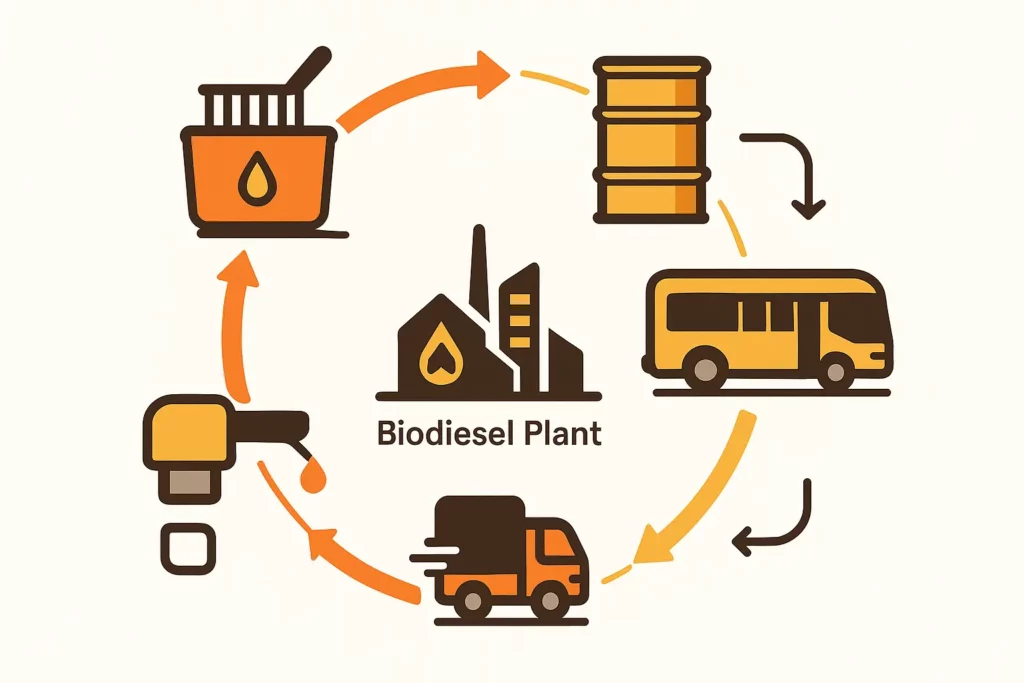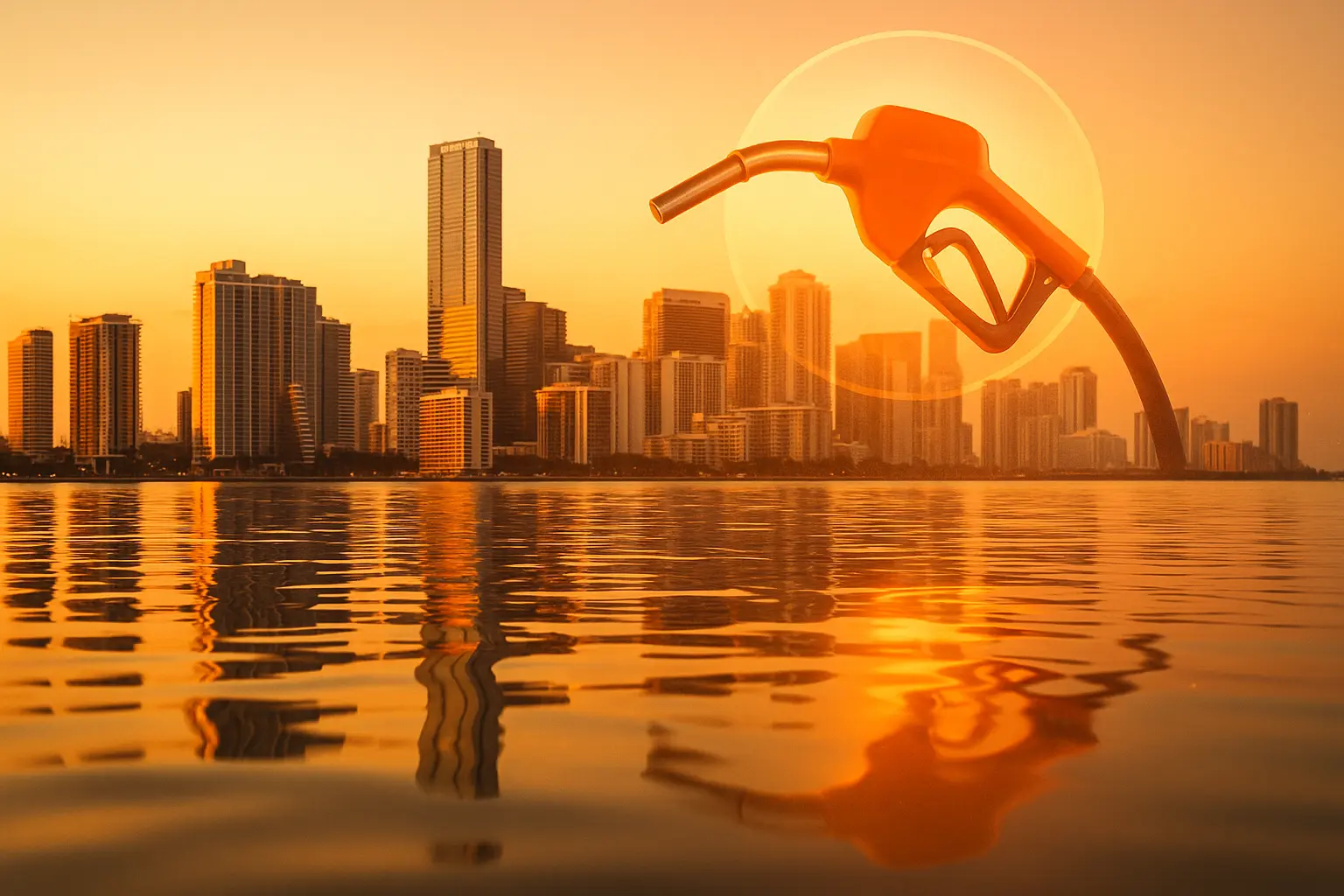Table of Contents
Biscayne Bay, Beaches, and the FOG Problem
Miami’s postcard shoreline hides a fragile plumbing network. Every time hot fryer oil slips down a sink, it cools inside the county’s 6,700 miles of sewer lines, congeals with food debris, and forms fatbergs. Miami‑Dade reports “several million dollars lost each year” jetting these clogs and repairing sewer overflows that spill bacteria‑laden water into canals feeding Biscayne Bay. The County’s Fats, Oils & Grease ordinance was tightened after EPA oversight to curb those spills, because 47 percent of U.S. sanitary‑sewer overflows trace back to FOG blockages
When restaurants divert that same oil to certified recyclers, clogs never form. Storm crews spend less time pumping backups, and mangrove nurseries avoid the smothering film that even a tablespoon of oil spreads across 1,000 square feet of water. For Miami’s tourism economy; where one closure notice can empty a dining room overnight; prevention beats cleanup. The environmental upside is immediate: clearer canals, healthier manatees, and beaches that stay open after heavy rain instead of posting “bacteria advisory” signs. Proper recycling is the simplest way a kitchen can protect the Bay without adding a dime to the municipal budget; because collectors haul it away free and resell it as feedstock.
From Fryer Drippings to Low Carbon Fuel
Used cooking oil is more than waste; it is a ready made lipid rich in energy. Through transesterification, Miami processors transform yellow grease into biodiesel that the EPA classifies as a “biomass‑based diesel” pathway, requiring at least a 50 percent lifecycle greenhouse‑gas cut versus petroleum diesel. Independent life‑cycle studies find waste‑grease biodiesel delivers up to an 86 percent CO₂‑equivalent reduction. Each gallon displaced keeps roughly 22 pounds of CO₂ from the air, meaning the average fast‑casual restaurant’s annual oil yield (about 1,200 gallons) neutralizes the tailpipe emissions of driving a car around the Earth.
Miami fleets already see the upside. County buses tested B20 blends after Hurricane Irma to stretch emergency fuel and cut black smoke plumes on evacuation routes. Because waste‑grease biodiesel is produced locally, supply chains stay short, creating circular‑economy jobs in Opa locka processing plants. The result: fewer tanker miles on I‑95, lower particulate pollution in Little Havana, and a resilient energy source when storms snarl ports. Recycling therefore tackles two crises at once; climate change and coastal vulnerability; while monetizing what once went down the drain.
Dollars, Wildlife, and the Cost of Dumping
FOG blockages don’t just generate bad odors; they force raw sewage into streets and, eventually, Biscayne Bay’s seagrass beds, where juvenile tarpon shelter. Cleanup bills average $3,600 per incident for small businesses; plumber fees, lost dinner service, and potential fines under the County’s FOG Discharge Control permit. Multiply that by hundreds of incidents and taxpayers foot a multimillion‑dollar tab every year.
Wildlife pays too. Sewage overflows spike nitrogen, fueling algae blooms that suffocate corals offshore. Pelicans coated in floating grease lose waterproofing and struggle to thermoregulate. By keeping oil out of drains and routing it to recyclers, kitchens directly maintain the clarity that reef tourism depends on; an industry worth $6.3 billion statewide, according to Visit Florida. This chain reaction; cleaner sewers, healthier reefs, stronger tourism; illustrates why recycled grease is an environmental bargain.
Storing and Preparing Your Used Oil for Pickup
Great recycling starts with disciplined storage. Let the fryer cool below 140 °F, skim particulate crumbs, then transfer the oil through a secure hose or capped caddy into a leak‑proof drum sized for your volume: 55 gallon for food trucks, 140 gallon for fast‑casual spots, 300 gallon for arenas. Position the container on level concrete away from storm drains; Miami’s afternoon downpours can overflow open lids and spread oil across parking lots. Indoor tanks or lidded outdoor drums with locking bars keep thieves from siphoning “liquid gold” that now fetches commodity prices.
Avoid mixing water or soap with the oil; moisture triggers microbial growth that spoils feedstock quality and can jam a collector’s pump. If your fryer filters oil for reuse, ensure staff know the difference between “extend life” filtering and “end of life” recycling: once free fatty acid levels rise or food browns too quickly, it’s time for the drum. Document fill levels in a simple log so you can schedule pickups before overflow. Collectors like Grease Connections provide barcode scanning on each service, creating digital manifests that satisfy County inspectors during surprise FOG audits. Good storage protects staff from burns, prevents parking‑lot slicks, and guarantees your oil retains its value all the way to the biodiesel plant.
Closing the Loop with a Certified Miami Recycler

Choosing a licensed recycler makes the environmental promise real. Look for companies that hold Miami‑Dade FOG permits, offer hurricane rated containers, and deliver service within 24 hours; even if a competitor’s tank still occupies your pad. Premium providers share monthly diversion reports, revealing exactly how many pounds of CO₂ you avoided. Some even return a rebate once market prices exceed hauling costs; turning waste grease into a micro‑revenue stream.
Ask whether the collector partners with local biodiesel blenders; shorter transport distances further cut emissions. Bonus points if the firm also cleans grease traps, because bundled service keeps one dispatcher accountable for your entire waste stream. Finally, verify spill insurance limits; rain soaked alleyways and post storm debris increase accident risk. A reputable partner shoulders that liability, freeing you to focus on food, not FOG.
When your kitchen follows the cycle; cool, store, collect, recycle; you convert a pollution headache into clean energy for Metrobus routes and backup generators. The payoff is tangible: smaller carbon footprint, healthier reefs, fewer plumbing surprises, and a sustainability story Miami diners love to share. That’s grease turned green, right in your backyard.









